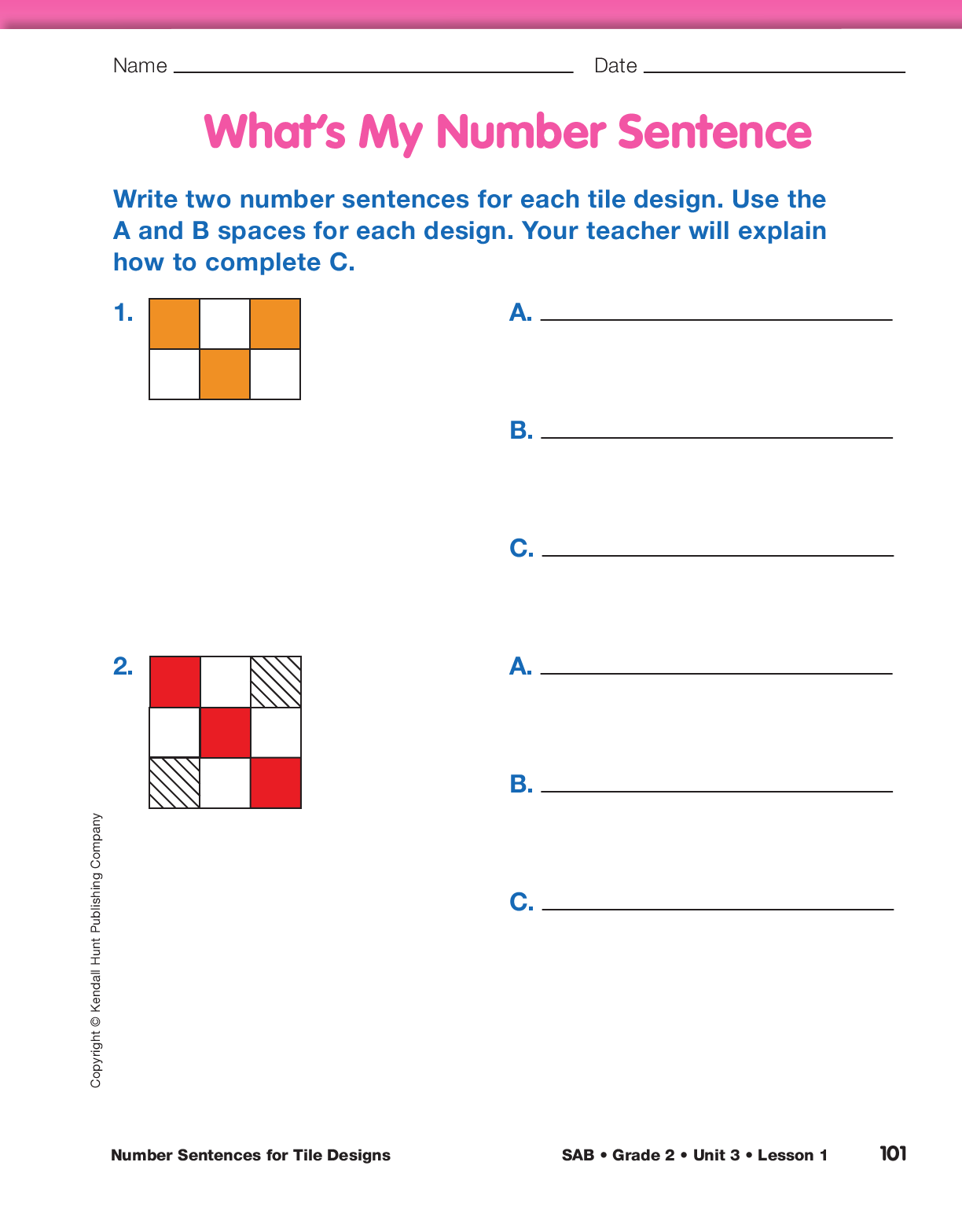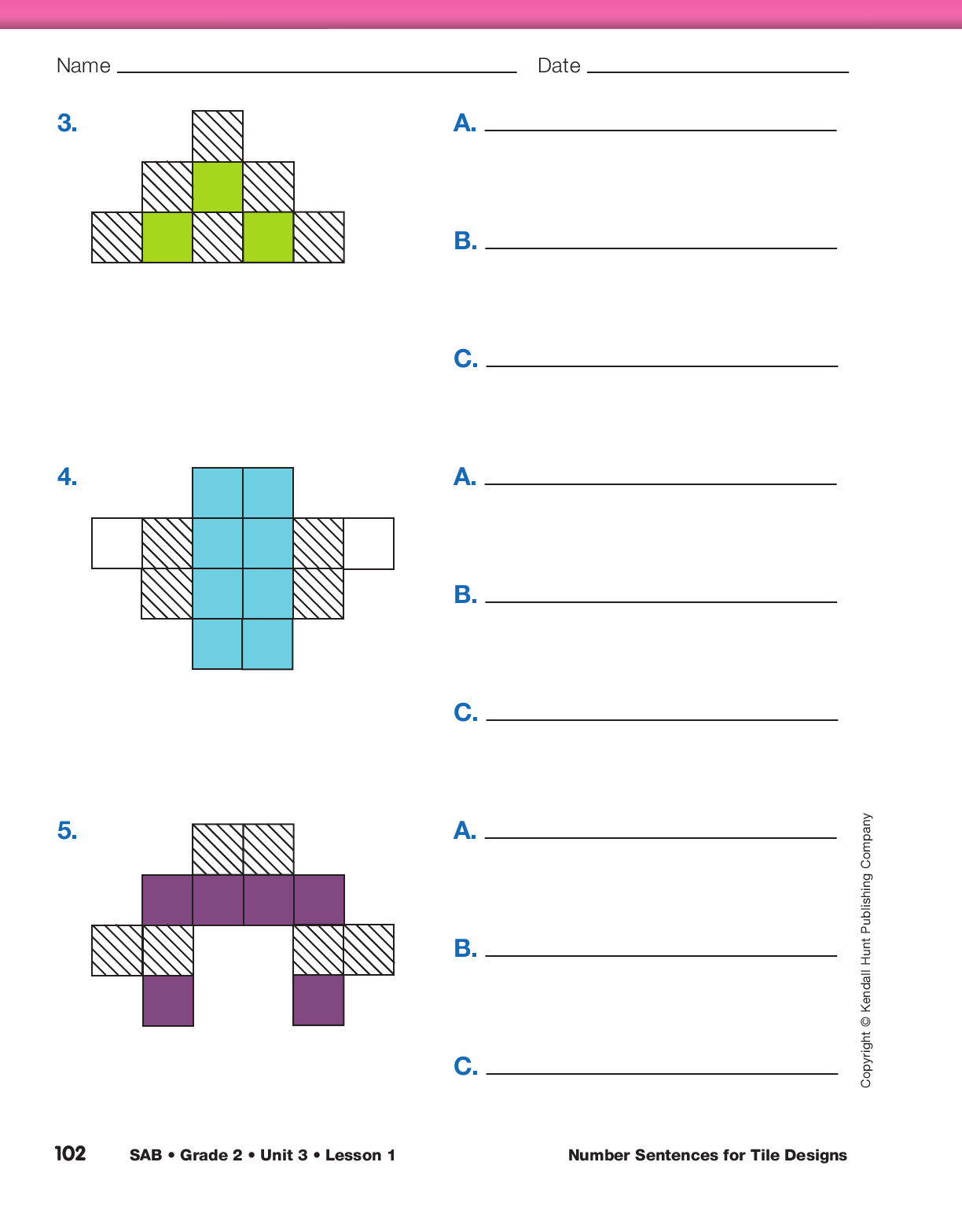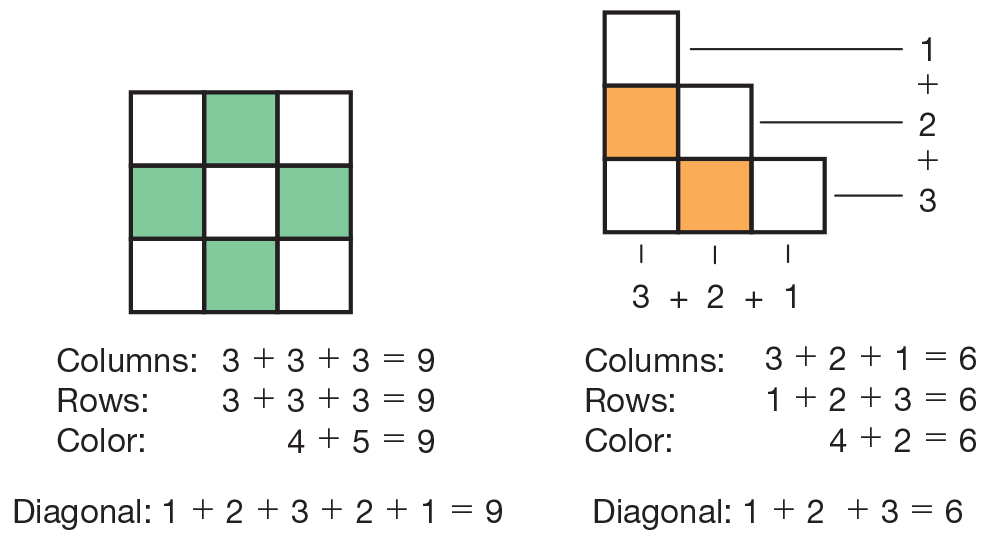Number Sentences for Tile Designs
Est. Class Sessions: 2Developing the Lesson
Part 1: Number Sentences for Tile Designs
Write Number Sentences. Display the square design (3 x 3) shown in Figure 1 that you prepared. See Materials Preparation. Using the tile design, show that the horizontal line of tiles is a row and the vertical line of tiles is a column. Ask students to tell you what the total number of tiles is. Then show the number sentence 3 + 3 + 3 = 9. Ask questions similar to the following as you point out the appropriate sections of the design.
Ask:
Show or have a student show the diagonal lines of tiles on the design.
Explain what diagonal means and ask:
Show the second tile design in Figure 1. As you discuss each of the number sentences, have a student point out the part of the design that corresponds to each addend in the number sentence.
Ask:
Create a new design. See Figure 2 for a sample design. Tell students to replicate this design with square-inch tiles and write a number sentence to describe it. Have different students write their number sentences on the board and show how each number sentence describes the design. Discuss the sentences with the class, emphasizing that there are usually different ways of representing the same problem.
Ask students to open the Student Activity Book to the What’s My Number Sentence pages. Use the display of the What’s My Number Sentence pages in the Student Activity Book to explain to students that they will write number sentences for the designs. At this time, they answer only parts A and B for each design. They will complete part C later in the lesson.
As students are working, circulate asking:
Introduce True or False Number Sentences.
Display the following number sentences:
- 6 + 2 = 8
- 8 = 6 + 2
- 5 + 2 = 8
- 8 = 5 + 2
Discuss these number sentences using these or similar prompts:
Write the following number sentences on a display one at a time.
- 8 = 8
- 8 = 10 − 2
- 6 + 2 = 2 + 6
- 6 + 2 = 4 + 4
- 6 + 2 = 8 + 0
For each number sentence, ask students to discuss the following with a partner:
Encourage students to use the strategies and tools
they have used in class for problem solving to prove
whether the statements are true or not. For example,
for Sentence D,
6 + 2 = 4 + 4, they can show a
train of 6 blue and 2 yellow cubes and another train
of 4 red and 4 green cubes, both trains totaling
8 cubes. Or they can describe counting on 2 from 6
and doubling 4, showing that both equal 8.
As students explain each number sentence, complete each conversation by representing the addition on both sides of the equal sign as follows:

Ask students to share their methods by showing how they used the tools either verbally or in a picture.
Combine Number Sentences to Represent Equal Statements. Display again one of the tile designs from Figure 1. Have students recall the number sentences suggested to describe it and write the number sentences on a display, one above the other. Ask the students if they agree that all the number sentences are true and describe the tile design.
Rewrite two of the number sentences as one sentence with more than one addend on each side of the equal sign. For example, for the 3 x 3 square in Figure 1, you have number sentences of 3 + 3 + 3 = 9 and 5 + 4 = 9. Rewrite the sentences as one sentence: 3 + 3 + 3 = 5 + 4. See Figure 4.
Ask:
Write a 9 immediately below as shown in Figure 4.
Display another of your earlier tile designs and go through the same process and questions.
Represent Equal Statements for Tile Designs. Show the display of the first What’s My Number Sentence page and have students look at their own pages that they completed. Call on a volunteer to tell you the two number sentences he or she wrote for Question 1. Write the two number sentences on the display of Questions 1A and 1B. Two possible number sentences are 2 + 2 + 2 = 6 and 3 + 3 = 6.
Ask:
Write 3 + 3 = 2 + 2 + 2 on the line of Question 1C.
Ask:
Have the student show, using tools or strategies, how 3 + 3 = 2 + 2 + 2. Represent the equality with the same notation as in Figure 4, showing both sides of the equal sign equal to 6.

Ask the same questions about another student's number
sentences for Question 2. In the same manner as
for
Question 1C, write the appropriate number sentence
that combines the two number sentences on
line 2C. For example, write 3 + 3 + 3 = 4 + 3 + 2.
Again, ask whether it is a true statement and have a
student show or describe using strategies or tools.
Use the same representation showing that both sides
of the equation equal 9.

Have students work in pairs to complete Questions 3C, 4C, and 5C, combining the two number sentences into one with 2 or more addends on each side of the equal sign. Have them show or explain to each other how they know that the sentences are true.




















